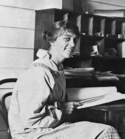Beatrice Hutton facts for kids
Quick facts for kids
Beatrice May Hutton
|
|
|---|---|

Beatrice Hutton, ca. 1916
|
|
| Born | 16 July 1893 |
| Died | 7 October 1990 |
| Nationality | Australian |
| Occupation | Architect |
Beatrice May Hutton (1893–1990), also known as Bea Hutton, was an amazing Australian architect. She made history on 30 October 1916. On that day, she became the very first woman to join an institute for architects in Australia. This was a big deal because other women, like Florence Taylor in 1907, had been turned away just for being female.
Contents
Life as an Architect
Beatrice Hutton was born on 16 July 1893. Her family lived at a place called The Folly in central Queensland. She was the second of seven children. Her dad, Falconer West Hutton, was a farmer and a surveyor.
Her family had to leave their farm in 1902 because of a drought. They moved to Rockhampton in 1906. Beatrice went to school at Rockhampton Grammar School.
How Beatrice Became an Architect
Beatrice Hutton did not go to university to study architecture. Instead, she learned on the job. She started her training in Rockhampton. First, she worked in her father's surveying office. She really wanted to be a surveyor. But she chose architecture because it was the closest job she could do.
Later, she became a student in an architecture office. This was the office of Edwin Morton Hockings, called Hocking and Palmer. She became the main person who drew plans for the firm. This happened when Mr. Hockings was away serving in the war.
Making History: First Woman Architect
Beatrice Hutton became the first woman to join an architectural group in Australia. She was accepted into the Queensland Institute of Architects on 30 October 1916. This was a huge step forward for women in architecture.
A newspaper called The Salon wrote about it. They said that Beatrice was a hard-working student. Her bosses also supported her application.
Beatrice was very interested in designing houses. She believed women had a special role in this. She felt women could design homes that were perfect for the local weather. They could also include features that saved people work. Some of the houses she designed in Rockhampton are still standing today. One famous one is the Rudd Residence.
Moving to Sydney
Beatrice moved to Sydney in late 1916. There, she mostly worked on designing homes. She also worked on bigger buildings. These included the New South Wales Masonic Club building (1927) and Sirius House.
From April 1917, she worked for another architect, Claude William Chambers. She became a junior partner in his firm from 1931 to 1933. Their company was listed as "Chambers and Hutton." Beatrice might have been the only woman running an architecture firm in Sydney at that time.
In 1934, she moved back to Rockhampton. She went to care for her elderly parents. This meant she stopped working as an architect.
Later Life and Other Talents
Beatrice Hutton's architecture career ended in 1933. She moved back to Rockhampton to care for her sick father. After her father passed away, she moved to Brisbane with her mother in 1936.
In Brisbane, Beatrice opened an art studio. It was in the Colonial Mutual Life Building on Queen Street. She showed and sold her beautiful wood carvings there.
Beatrice loved using her creative skills. She also did pottery and made rugs. She even briefly returned to architecture in 1940. She died on 7 October 1990 in Indooroopilly, Brisbane.
Remembering Beatrice Hutton
Beatrice Hutton is remembered in several ways:
- The Beatrice Hutton Award for Commercial Architecture is given by the Australian Institute of Architects.
- There is a Beatrice Hutton room at the Rockhampton Art Gallery.
- A house at Capricornia College in Central Queensland University is named Beatrice Hutton House.
Projects
Here are some of the projects Beatrice Hutton worked on:
- J. W. Dalzell residence, Rockhampton (around 1916)
- Myles House, Rockhampton (around 1919)
- H Rudd house, Rockhampton (1923)
- 'Ngarita', Bellevue Hill, Sydney (1923) – this project is also linked to her uncle's brother, James Vicars.
- Brecknell Street, Rockhampton (1926)
- NSW Masonic Club building (1927)
- Sirius House, Macquarie Place

